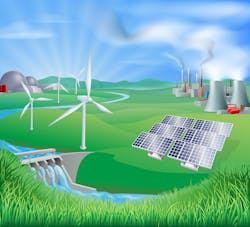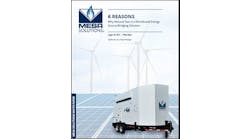Renewables and microgrids are natural companions on the electric grid. Could the day come when we have a grid of all microgrids run on 100 percent renewables?
For most advanced economies the idea of no centralized grid and no fossil fuels is at best far in the future. But all audacious goals begin one step at a time. And such is the case for a campaign to make the world’s energy supply all renewable.
Notably, two U.S. states that often lead the way on green energy policy — California and Massachusetts — are now looking at becoming part of movement. At the same time, a government research body in Australia recently found the 100 percent goal to be technically possible for the nation.
“As renewables continue to become the most economical, resilient energy option, especially in the electricity sector, 100 percent renewable energy goals have continued to become a growing trend around the world, with cities and states increasingly seeking to bind targets with legislation,” said Diane Moss, founding director of the Renewables 100 Policy Institute.
The idea of pushing for a world that uses only renewable energy emerged in the mid-2000s with Hermann Scheer, former general chairman of the World Council for Renewable Energy. It was slow going at first. But with falling prices for wind and solar and a ground-up consumer push for green energy, the effort has accelerated.
Look who’s on board
By 2013, eight countries, 42 cities, 49 regions had either reached the 100 percent renewables goal or were determined to do so, according to the Renewables 100 Policy Institute.
Today the institute says the numbers are up to more than 50 countries, 69 cities and 62 regions/state.
Among U.S. states, Hawaii has led the way with a 2015 law requiring that electric utilities generate all of their power from renewables by 2045. A bill (SB 1186) is now being considered that would require the transportation sector use 100 renewables as well.
More than 50 Massachusetts lawmakers want to take it one step further in their state. They’ve signed onto a bill (HD.3357) that would make the state’s entire energy economy – electricity, heat and transportation – run on renewable energy by 2050. The electric grid would be required to reach the goal first – by 2035.
Meanwhile, California’s Senate leader Kevin de León last month introduced legislation (SB 584) that would make the state’s electric grid all renewable by 2045.
Other states also are pushing aggressive goals – if not 100 percent. Vermont, for example, is striving for 90 percent renewables by 2050. New York wants renewables to fuel 50 percent of its electricity by 2030, a goal that helped spur a 795 percent increase in solar installations over the last five years. New York’s Gov. Andrew Cuomo reported last week installation of 64,926 projects, enough to power 121,000 homes.
Ciities are on the move too. Burlington, Vermont and Greensburg, Kansas are already 100 percent renewable. Kodiak Island in Alaska is almost there, using 95 percent renewables. Pueblo, Colorado last month voted to pursue the goal, as did Boulder last year. A sprinkling of cities in other states are pursuing the goal as well, with California topping the list. Among its cities pursuing the goal are Lancaster, Del Mar, Palo Alto, San Jose, San Francisco and San Diego.
Some worldwide examples include Costa Rica, which periodically runs on all renewables. Munich, Germany is on the list of those striving for the goal, as is Copenhagen, Denmark. Canberra, the Capitol of Australia, legislated a 100 percent renewable power goal by 2020. (The Renewables 100 Policy Institute keeps a list here.)
Why renewables and microgrids as partners?
Renewables and microgrids are natural companions. For one, new microgrids increasingly include solar plus storage. But perhaps more significant, microgrids act as a kind of counterbalance on the grid to the intermittency of renewable energy.
When a cloud suddenly passes over a solar panel or the wind stops and turbines slow, a microgrid can quickly inject energy and services into the grid. This keeps power flowing steadily so that consumers experience no dip in service – or worse a power outage. Using its own highly intelligent software system, the nearby microgrid draws upon its various internal resources – perhaps energy storage or combined heat and power – to serve the grid.
For this reason, the more renewables we add, the more microgrids we will need. Microgrids are newer to the game than renewables, just recently getting off the ground as an industry. But as renewables continue to rise in use, expect to see microgrids do the same.
It’s still the economy, stupid
There are a range of reasons states pursue renewable goals: environmental concerns, a desire for local control over energy, the benefit of free fuel. But one of the biggest reasons is economic growth.
These states want to draw in manufacturers, software designers, installers and other green energy businesses. Why? Because the clean, green and advanced energy sector is growing fast.
Consider these statistics from a January 2017 report by the U.S. Department of Energy. Of the 26 GW of utility-scale electric generation added to the U.S. grid in 2016, about 93 percent came from three main resources: solar (9.5 GW), natural gas (8 GW), and wind (6.8 GW).
As a result, renewables, along with related advanced energy sectors, such as energy efficiency, offer a lot of jobs. The Advanced Energy Economy recently pegged the number at 3.3 million jobs – equal to the employment of retail stores across the country, and twice as many jobs as involved in construction of buildings.
Given the hoopla from the federal government about the loss of coal jobs, it may come as a surprise how few jobs coal produces compared to the clean energy sector. Coal mining – which the Trump administration hopes to revive – reached a peak employment of just under 90,000 jobs in 2012 and now employs 53,000 people, according to the DOE. By way of comparison, AEE pegged jobs in the energy efficiency sector at 2 million.
“People often don’t realize that energy efficiency is such a huge jobs creator,” said Kateri Callahan, president of the Alliance to Save Energy. “It supports about three times as many jobs as the mining industry and unlike that sector it is growing and creating good-paying jobs like weatherizing homes and manufacturing high-efficiency appliances or building materials.”
Beating expections
Despite this growth, renewables still have a long way to go before they reach 100 percent in the U.S. Renewables only accounted for 15.3 percent of domestic electrical generation in 2016, according to the Sun Day campaign, which tracks data from the U.S. Energy Information Administration (EIA).
But the sector has been beating government expectations. Renewable use made a big leap — 23 percent — from last year. EIA had expected only a 9.5 percent rise, according to the Sun Day campaign.
“Given the trends of recent years, it is probably no great surprise that solar, wind, and other renewable sources once again surpassed EIA’s expectations,” said Ken Bossong, executive director of the Sun Day Campaign. “Yet, EIA continues to low-ball its latest forecasts for renewables thereby doing a serious disservice to the cross-section of rapidly growing clean energy technologies.”
Now for the really audacious
Here’s an even more audacious goal. Can we talk about pursuing 100 percent renewables and microgrids?
There are energy visionaries today, who like Herman Scheer a decade ago, are talking about the grand idea that they call a grid of grids. Nationwide, a chain of local networks would provide our power, trading among each other via complex algorithms, set for highest efficiencies and cost-effectiveness.
Very early work is already underway on configuring this grid of grids. Exelon subsidiary Commonwealth Edison, is working on a master controller to oversee multiple microgrids. And small companies like California-based CleanSpark and big companies like General Electric are working on projects that offer first steps toward a constellation of microgrids operatingn on the U.S. grid.
Microgrids use a lot of different resources, not just renewables. So it’s not a given that a grid of grids would be all renewables. Still, these two resources — renewables and microgrids — seem to be moving into the future on the same track, one where energy becomes increasingly clean, efficient and distributed.
So in 10, 20, 30 years could we have a grid of all renewables and microgrids? Is it crazy or possible? Tell us what you think. Post your comments below or on our LinkedIn Group, Microgrid Knowledge.
Read more about renewables and microgrids by subscribing to the Microgrid Knowledge newsletter. It’s free.







